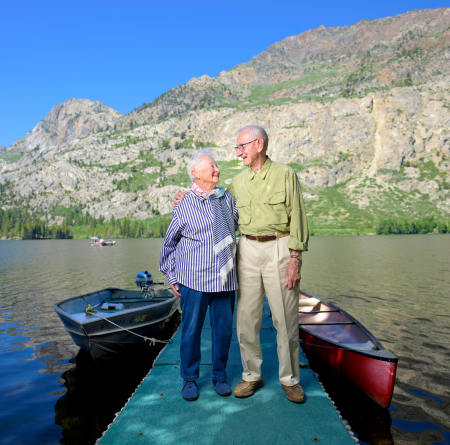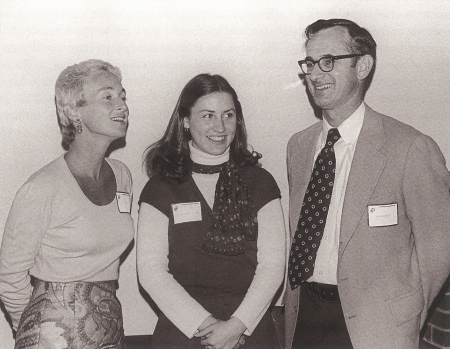Jack Stark ’57 GP’11 describes his mark on Claremont McKenna College in one word: community.
A community that cherishes faculty-student relationships, encourages an entrepreneurial spirit, and values every employee—from the grounds crew to the deans.
Reflecting on his 29 years as the third president of CMC, spanning 1970 to 1999, Stark said the College’s culture of community made it possible to achieve what many thought impossible—to catapult Claremont McKenna into an academic and fundraising powerhouse.
“I certainly had big goals and principles when I was president,” said Stark, who turned 90 in September, and led his first years at his alma mater when it was Claremont Men’s College. “Some of the plans were very well thought out, and other parts of my success were just trying new things and hoping they would work.”
His determination and thirst for innovation paid off. Under his watch, the College’s endowment grew 45-fold; admissions became highly selective; research institutes and the beloved Marian Miner Cook Athenaeum were launched; and hallmark programs, such as study abroad and Washington, D.C., were established.

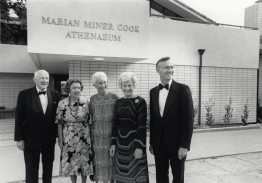

Top: Jack and Jil Stark inside Bauer Center
Center: (left to right) Donald McKenna, Bernice McKenna, Jil Stark, Marian Miner Cook, and Jack Stark during the dedication of the Marian Miner Cook Athenaeum.
Bottom: Jack Stark, Pamela Gann, and Hiram Chodosh reflect on their respective CMC presidencies during an Alumni Weekend panel in 2022.
But perhaps most significantly—and among Stark’s proudest accomplishments—the College voted to admit the first class of women in 1975, a milestone that is approaching its 50th Anniversary next year.
“My idea of good leadership is projecting the future and getting your people prepared to meet the challenges along with you,” he said. “We knew co-education was coming—Yale, Princeton, Colgate, Brown, Duke, and Dartmouth, among others, went co-ed in the early 1970s. Society had changed very fundamentally. This was not a pendulum that was going to swing back, and an institution that did not admit women would have had a hard time calling itself a leader.”
Stark used his keen skills in diplomacy and leadership to drive co-education forward and ultimately win approval from the Board of Trustees (see below). That first year, 25% of the class was women (higher than Yale or Brown in their first year of co-education).
“We took the best students; we did not make it special,” he said. “We got a group of terrific women who came in and they were real, real pioneers.”
Through it all, Stark said his secret weapon was—and remains—his wife Jil (Harris) Stark GP’11, a 1958 Scripps College graduate, honorary CMC alumna, and former Director of the Ath, whom Jack married the day after her graduation. They met when Jack was a sophomore, the day after Jil arrived as a freshman at Scripps. “My partnership with Jil was the key to any bit of success I had at CMC during my presidency.”
Together, the Starks have become synonymous with CMC. But getting to an upstart liberal arts college in Claremont, Calif. from Urbana, Ill., a small farming town in the northeastern part of the state, certainly was not a given.
Born in 1934, Jack grew up playing basketball, fishing, and participating in the Boy Scouts. His father was a salesman and his mother a homemaker, tending to the needs of Jack and his younger sister, Barbara. Their world dramatically changed at age 13 when the family moved to National City, south of San Diego. His family purchased a hardware store, where Jack worked on weekends and after school.
“In high school, I was a debater and there was a debate tournament in Claremont,” he said. “That was the first time I ever visited The Claremont Colleges. A friend happened to be applying to Claremont Men’s College. And I said, ‘Well, can you ask for two applications?’ So, I applied, was accepted, and given a scholarship. I was first in my family to attend college, so it was new for everyone.”
Jack, a Literature and Economics double major, was active and well-liked on campus. He was class president in his sophomore year, ASCMC Vice President in his junior year, and an RA at Boswell Hall in his senior year.
Just as Jack’s application to CMC came by happenstance, so did his first job at Claremont Men’s College. After finishing three years as a captain in the Marine Corps, the now-married, father of a newborn popped by the CMC Registrar’s office to pick up his transcripts. His plan was to apply for an MBA.
“I ran into CMC’s President (George C.S.) Benson, whom I knew fairly well. He asked me if I was interested in working for him. I thought, ‘Well, I have a wife and new baby and no money, so it’s probably the responsible route.’”
Initially, Jack served as Director of Alumni Relations, and after working in nearly every department—including buildings and grounds, new construction, human resources, and career counseling and placement—he rose to Chief Financial Officer and assistant to President Benson P’61. He likes to joke that the administration was so small in the 1960s that you could fit everyone into one car.
In June 1970, outside forces once again determined his future. Although Jack and Jil (they now had three children) were days away from boarding a plane for a one-year sabbatical at Oxford University in England, the current CMC President, Howard Neville, unexpectedly resigned after one year at the helm.
“It was a tumultuous time on American campuses and at CMC due to the Vietnam War,” Jack said. “When President Neville arrived, there were repeated confrontations, including sit-ins and broken windows due to student protests at the ROTC headquarters in Bauer Center. It wasn’t something a newly arriving president was prepared to handle.”
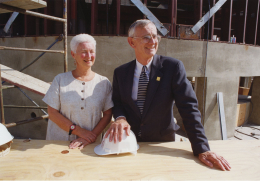

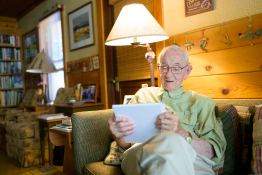
Top: Jack and Jil Stark outside a construction area
Center: Jack Stark, seen here with his granddaughter Alyson N. Stark Velasquez ’11
Bottom: Jack Stark looks at family photos inside the Starks’ 1924 cabin on Silver Lake in Mono County, Calif.
Due to his work with students and running the business side of the College, the Board of Trustees asked a surprised Jack—who was just 35 years old—to serve as interim president. Six months later, he was one of three finalists for CMC’s third president. “I never got a letter, much less a contract. I just figured I worked for the Board and when they got tired of me, I’d get a phone call that said, ‘we’re terminating your salary.’ So, it was a very different time.”
Among his goals was to establish student-oriented research institutes and centers alongside the Salvatori Center for Individual Freedom, launched in 1967 under President Benson. “My feeling was that a liberal arts college is different from a university. Teaching is of great importance to us. We value research because it keeps a faculty member alive and active in his or her field. And of course, we want the faculty member to participate in the governance of the College. The institutes have allowed us to bring in faculty members interested in spending a lot of time working with students on research projects and teaching our classes.”
When Jack retired in 1999, CMC was home to seven institutes and research centers. Today, there are 11.
Another point of pride was the establishment of the Athenaeum. Originally envisioned by Donald C. McKenna, Jack offered the president’s home to serve as the dinner meeting spot in 1970. In 1982, the Marian Miner Cook Athenaeum was erected in the middle of campus thanks to a gift by Cook.
The Ath has since become the campus centerpiece for student social engagement, viewpoint diversity, and constructive dialogue at CMC. Jil, the third Director of the Ath, had a major part in establishing its current identity—a highlight of her time at CMC. “Exchanging ideas outside of the classroom and over dinner was pretty special,” she said. “And of course, the tradition carries on today and continues to be exciting and a high point for many.”
Those who worked with Jack throughout the years said his greatest strength was encouraging excellence and having clear goals and ambitions for the College. His inclusive approach inspired many to commit long hours to his drive for growth and success, said Linda Davis Taylor, the first female in CMC’s cabinet, who worked as Dean of Admission and Financial Aid from 1982-1987.
“As President, Jack articulated a clear strategic vision, set aspirational goals, and motivated his team to achieve outstanding results,” said Davis Taylor. “He fostered an environment in which individuals were encouraged to excel, but not at the expense of the College’s culture. It was like being part of a family—everyone had their role, and the whole was greater than the sum of the parts. This made CMC an inspiring place to work and the institution’s progress unstoppable.”
When Jack retired in 1999, he was the longest-serving college president in California and perhaps the only one without an advanced degree. His longtime assistant, Barbara Condit, who was promoted to Assistant Vice President, said there was never a dull moment at CMC.
“We worked in the eye of the hurricane,” she said. “Jack had principles and goals for the College and never wavered from what he truly believed in.”
Today, the Starks are regulars at Ath dinners and other CMC events, including Alumni Weekend, Family Weekend, and Commencement. They live a few miles from campus in the retirement community Mt. San Antonio Gardens, and still consider CMC their second home. In retirement, Jack and Jil spend time with their four children, eight grandchildren, and three great-grandchildren, who also live in Claremont or close by.
They never miss a summer at their 1924 cabin on Silver Lake in the Eastern Sierra. The couple drives their 2017 Jeep 330 miles north, where they fish for trout, hike, work on puzzles, and read in the rustic cabin.
This summer, all 23 members of their close-knit family gathered at the cabin for a week of cooking and fun in the water. “And what is really special and amazing is we all like each other and love spending time together,” said Jil.
Jack continues to serve on the CMC Board of Trustees as a life trustee. His contributions are indelibly remembered through the Jack L. Stark Distinguished Service Award, given in recognition of outstanding service to the College, and the Jack L. Stark Society, a gift club level for CMC donors. Stark Hall, Claremont McKenna’s substance-free residence hall, is also named in his honor.
In September, his beloved alma mater celebrated Jack’s 90th birthday with a campus birthday party attended by his family and members of the CMC community.
“I have had a long and exciting life, with many unexpected opportunities,” Jack said. “I continue to look to the future with great optimism. I am very proud of Jil, our four children, and their families. A total of 23 Starks, so far! I also consider CMC more or less our fifth child.”
